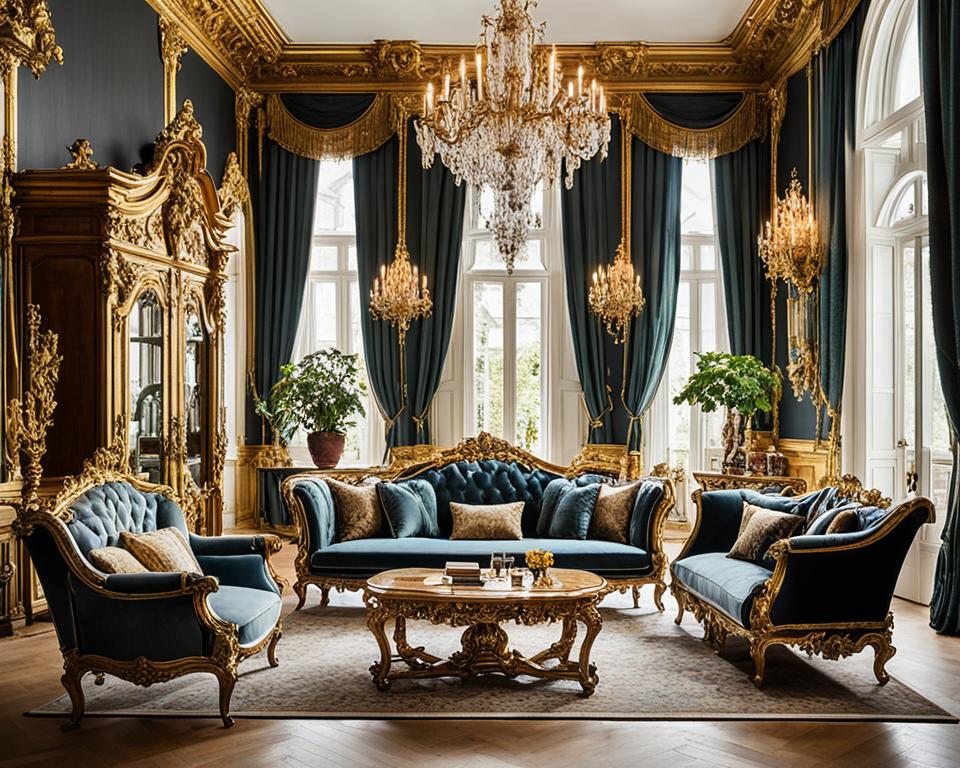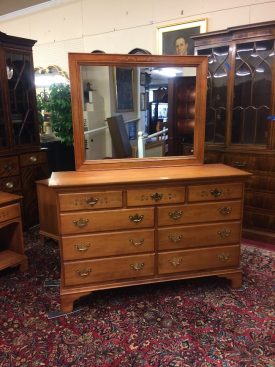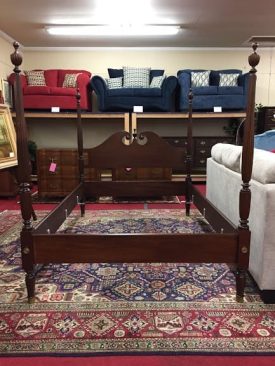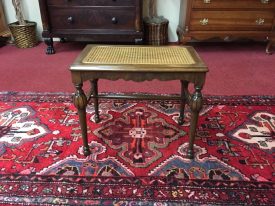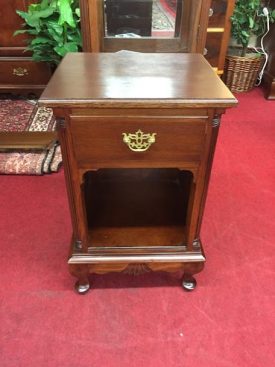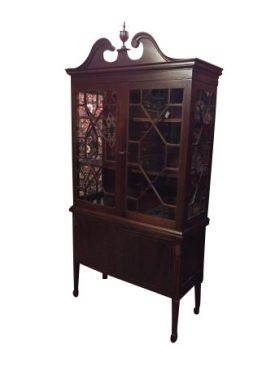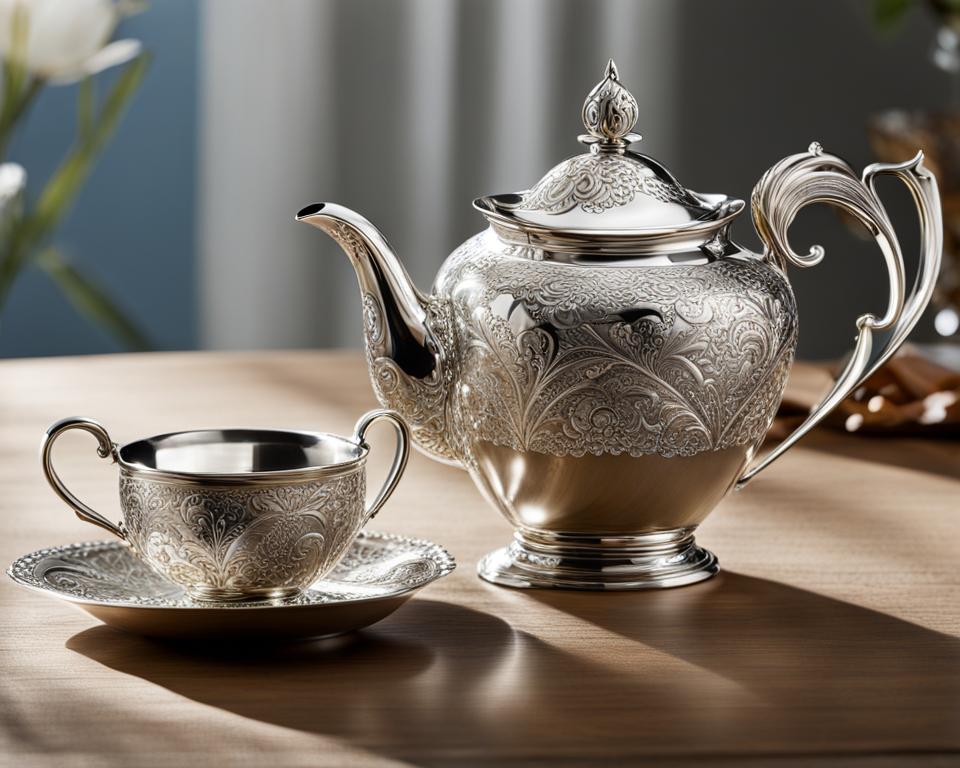The world of interior design is a canvas where history and aesthetics merge to create unique, captivating spaces. The Baroque period stands out as a timeless testament to opulence, extravagance, and intricate craftsmanship. Baroque antique furniture, known for its ornate carvings, intricate detailing, and curvilinear forms, embodies the essence of the Baroque era. In this article, we will explore the origins, evolution, and present-day relevance of Baroque antique furniture.
Key Takeaways:
- Baroque antique furniture showcases opulence, extravagance, and intricate craftsmanship.
- Its ornate carvings, intricate detailing, and curvilinear forms define the essence of the Baroque era.
- Baroque antique furniture adds a touch of timeless elegance to any space.
- The origins and evolution of Baroque antique furniture are fascinating and rich in history.
- In today’s era of minimalist and modern design, Baroque antique furniture has experienced a resurgence in popularity.
A Glimpse into Baroque Elegance: Origins and Characteristics
The Baroque era, spanning from the late 16th to early 18th century, is known for its grand and visually striking interiors. Among the exquisite pieces that epitomize this era are the Baroque tables, renowned for their ornate carvings, intricate detailing, and curvilinear forms. These tables were adorned with elaborate motifs inspired by nature, cherubs, and mythological figures, resulting in a captivating visual narrative. Made from rich, dark woods like walnut and mahogany, Baroque tables exuded a luxurious and timeless appeal.
One notable feature of Baroque tables is their ornate carvings. Skilled craftsmen painstakingly carved intricate designs into the wood, showcasing their mastery of the art form. Whether it was delicate floral motifs or intricate patterns inspired by classical architecture, these carvings added a touch of opulence and grandeur to each piece. The attention to detail was unparalleled, with every curve and contour meticulously crafted to enhance the overall aesthetic.
The Baroque period was also characterized by the use of intricate detailing in furniture design. Baroque tables often featured meticulously engraved patterns or motifs on their surfaces, further enhancing their visual appeal. These intricate details added depth and texture to the furniture, elevating it from mere functional pieces to true works of art. The level of craftsmanship involved in creating these intricate designs is a testament to the dedication and skill of the artisans of the time.
Curvilinear forms were another distinctive feature of Baroque tables. The tables’ legs were intricately crafted, often featuring graceful, flowing curves that added a sense of movement and elegance to the overall design. These curvilinear elements were inspired by the natural world, with the flowing lines reflecting the organic shapes found in nature. The combination of the ornate carvings, intricate detailing, and curvilinear forms resulted in furniture pieces that exuded a sense of grandeur and sophistication.
Overall, Baroque tables embody the essence of the Baroque era with their ornate designs, intricate craftsmanship, and opulent materials. Whether used as a centerpiece in a grand dining room or as an accent piece in a luxurious living space, these tables continue to be admired for their timeless elegance and ability to elevate the aesthetic of any room.
Stay tuned for the next section to discover the evolution of Baroque tables through different styles and regions.
Evolution through the Ages: Baroque Tables in Different Styles
As time progressed, the Baroque style evolved and gave birth to various sub-styles that retained the opulence of the original while infusing unique regional and artistic influences. German Baroque furniture, for example, featured intricate carvings inspired by natural motifs and religious symbolism. Swiss Baroque furniture leaned toward a more refined and practical elegance. Italian Baroque furniture incorporated sculptural elements into its design, creating pieces that were almost works of art. Belgian Baroque furniture often featured decorative carved motifs inspired by nature. Each regional style added its own distinct charm to the Baroque tables.
To get a better understanding of the different styles of Baroque tables, let’s explore each in more detail:
German Baroque Style
German Baroque furniture stands out with its intricate carvings that often draw from natural motifs and religious symbolism. These dynamic, asymmetrical pieces are skillfully crafted of dark woods such as walnut and oak, reflecting regional preferences and rich ornamentation. German Baroque tables, in particular, feature remarkable spiraling legs, elaborate carvings, and unique personalities that add character to any room.
Swiss Baroque Style
Unlike the slightly more extravagant German Baroque furniture, Swiss Baroque furniture leans toward a more refined and practical elegance. Swiss Baroque tables, made of massive walnut wood, often have a central slate slap for holding hot pots and can seat up to ten people. The dark wood lathed legs connected by a crossed stretcher give them stability and a touch of sophistication.
Italian Baroque Style
Italian Baroque furniture is known for its intricate carvings, voluptuous curves, and opulent materials. Italian Baroque tables often feature stunning cherry wood designs with intricate legs carved in a lyre-shaped walnut. These pieces showcase the masterful incorporation of sculptural elements into furniture, creating works of art that transcend their utilitarian purpose.
Belgian Baroque Style
Belgian Baroque tables often have decorative carved motifs inspired by nature, such as foliage and flowers. They have bold, robust forms with curvaceous lines that give them a sense of movement and vitality. These tables, made of hand-carved oak with rocaille, flower, and leaf decorations, add charm and elegance to any living room or entryway.
Each Baroque style offers its own unique flair and aesthetic, creating diverse options for those seeking to incorporate Baroque design furniture into their homes. Whether you prefer the elaborate carvings of German Baroque, the refined elegance of Swiss Baroque, the sculptural artistry of Italian Baroque, or the natural motifs of Belgian Baroque, there is a style to suit every taste and enhance any space.
German Baroque Style
German Baroque furniture is renowned for its intricate carvings and exceptional craftsmanship that often draw inspiration from natural motifs and religious symbolism. These dynamic and asymmetrical pieces reflect regional preferences and showcase rich ornamentation, making them exquisite examples of Baroque design furniture.
One of the standout features of German Baroque tables is their remarkable spiraling legs. Crafted with precision and attention to detail, these legs create a sense of movement and add a touch of drama to the overall design. Elaborate carvings adorn every corner, displaying the mastery of German artisans in bringing intricate patterns to life.
The use of dark woods such as walnut and oak further enhances the luxurious appeal of German Baroque furniture. These materials not only provide a rich color palette but also lend durability and longevity to the pieces. The combination of intricate carvings, dark woods, and unique design elements gives German Baroque tables their distinctive personality and unmistakable charm.
German Baroque furniture fits beautifully in a variety of interior styles. Its elegance and opulence make it a striking addition to traditional or classic baroque furniture, where it complements the intricate detailing and ornate motifs of the overall aesthetic. However, these timeless pieces also bring a touch of sophistication and grandeur to more contemporary spaces, creating a beautiful juxtaposition between the old and the new.
The German Baroque style offers a glimpse into the rich history and artistry of the Baroque era. Whether as a focal point in a grand dining room or as an accent piece in a cozy living space, German Baroque tables showcase the craftsmanship and design brilliance of this iconic period.
Examples of German Baroque Tables:
| Table | Description | Image |
|---|---|---|
| German Baroque Dining Table | A grand dining table adorned with intricate carvings, featuring a solid walnut top and spiraling legs. | |
| German Baroque Console Table | A beautiful console table with elaborately carved details, combining oak and walnut for a harmonious contrast. | |
| German Baroque Coffee Table | A smaller-scale coffee table with intricate floral carvings and a dark walnut finish, perfect for adding flair to a living room. |
Swiss Baroque Style
Unlike the slightly more extravagant German Baroque furniture, Swiss Baroque furniture leans toward a more refined and practical elegance. Swiss Baroque tables, made of massive walnut wood, often have a central slate slap for holding hot pots and can seat up to ten people. The dark wood lathed legs connected by a crossed stretcher give them stability and a touch of sophistication.
| Features | Materials | Functionality | Seating Capacity |
|---|---|---|---|
| Refined and practical elegance | Massive walnut wood | Central slate slap for holding hot pots | Up to ten people |
Swiss Baroque furniture showcases the epitome of style, combining the intricate craftsmanship of the Baroque period with a practical approach. These tables exude sophistication and make a statement in any room they grace, seamlessly blending functionality with timeless elegance.
Italian Baroque Tables
Italian Baroque furniture is renowned for its intricate carvings, voluptuous curves, and opulent materials. One of the most striking examples of Italian Baroque furniture is the Baroque tables. These tables are known for their exquisite craftsmanship and the masterful incorporation of sculptural elements.
Italian Baroque tables often feature stunning cherry wood designs, known for their warm, rich tones and beautiful grain patterns. The table legs are a standout feature, intricately carved in a lyre-shaped walnut motif. This distinctive design adds a touch of elegance and sophistication to any space.
The attention to detail in Italian Baroque tables transforms them from mere functional pieces of furniture into works of art. The intricate carvings on the legs and table apron showcase the meticulous craftsmanship that was characteristic of the Baroque period. These tables are not just items of furniture; they are pieces that transcend their utilitarian purpose and become a focal point in any room.
Italian Baroque tables are versatile and can be incorporated into various design styles. Whether placed in a grand dining room, an elegant living area, or even a modern space seeking a touch of classic luxury, these tables effortlessly elevate the ambiance and create a sense of refined opulence.
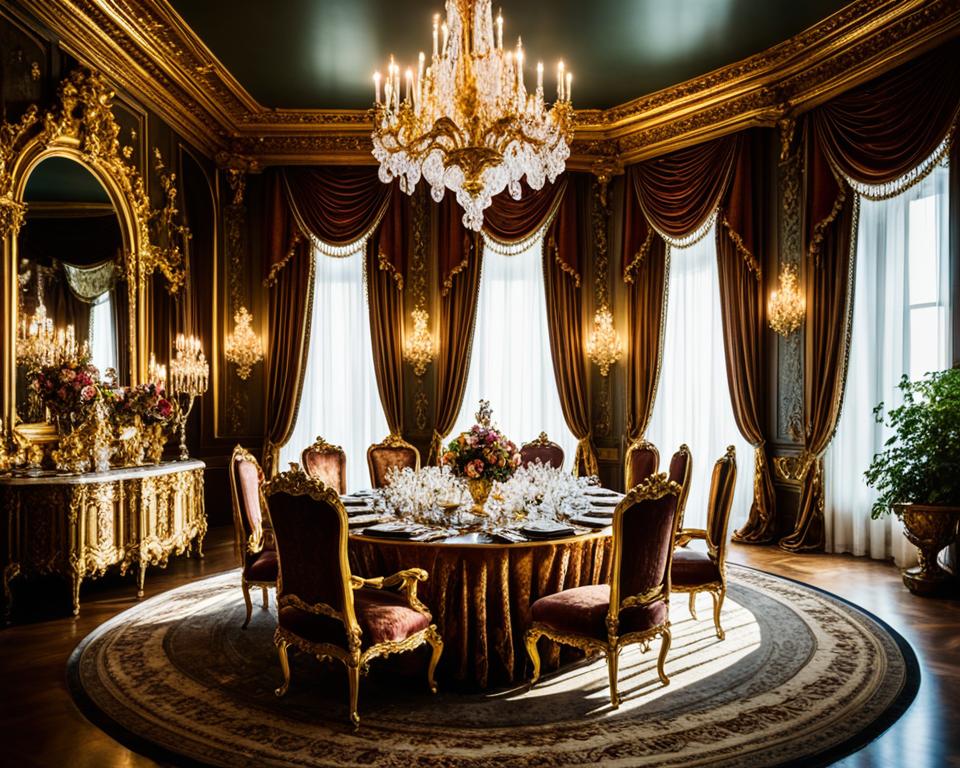
The Elegance of Italian Baroque Tables
| Features | Description |
|---|---|
| Intricate carvings | The legs and apron of Italian Baroque tables are adorned with elaborate carvings, showcasing the skill and artistry of the craftsmen. |
| Voluptuous curves | The table legs are often designed in a graceful lyre shape, adding a sense of movement and elegance to the overall structure. |
| Opulent materials | Italian Baroque tables are crafted from luxurious woods like cherry and walnut, enhancing their visual appeal and durability. |
| Sculptural elements | The incorporation of sculptural elements into the design of Italian Baroque tables transforms them into pieces of art that transcend their utilitarian function. |
Italian Baroque tables are not only furniture; they are expressions of the rich history and artistic prowess of the Baroque era. Their timeless beauty and exquisite craftsmanship make them highly sought-after pieces for those seeking to bring a touch of classic elegance into their homes.
Belgian Baroque Style
In the realm of Baroque furniture, Belgian Baroque style stands out with its unique charm and exquisite craftsmanship. Belgian Baroque tables are renowned for their decorative carved motifs, inspired by nature’s beauty, featuring intricate foliage and flower designs. These tables exude a sense of elegance and sophistication, making them a perfect addition to any living room or entryway.
Made with meticulous attention to detail, Belgian Baroque tables are crafted from hand-carved oak, showcasing the exceptional talent of skilled artisans. The robust forms and curvaceous lines of these tables create a dynamic visual appeal, evoking a sense of movement and vitality in any space they grace. The rocaille, flower, and leaf decorations add a touch of whimsical beauty, elevating the overall aesthetic.
Belgian Baroque furniture, including these exquisite tables, is known for its timeless design and enduring quality. The classic baroque furniture elements seamlessly blend with contemporary interiors, effortlessly adding a touch of historical charm and character. Whether placed in traditional or modern settings, these tables enhance the ambiance with their refined elegance, creating a captivating focal point.
Experience the allure of Belgian Baroque style with its mesmerizing carved motifs and remarkable craftsmanship. Explore the artistry of these exquisite tables that blend history, nature, and impeccable design.
| Features | Materials | Dimensions |
|---|---|---|
| Decorative carved motifs | Hand-carved oak | Varies based on design |
| Robust and curvaceous forms | ||
| Rocaille, flower, and leaf decorations |
Baroque Tables: Historical Relics Fit for Any Home
In today’s era of minimalist and modern design, Baroque antique furniture has experienced a resurgence in popularity. The timeless appeal of its intricate craftsmanship and artistic flair has made it a sought-after addition to a variety of spaces. The ornate detailing and rich craftsmanship of Baroque tables inject elegance and opulence into any room, enhancing its classic charm.
These historical relics effortlessly integrate into rooms of any style, making them transformative pieces that elevate the aesthetic of any space.
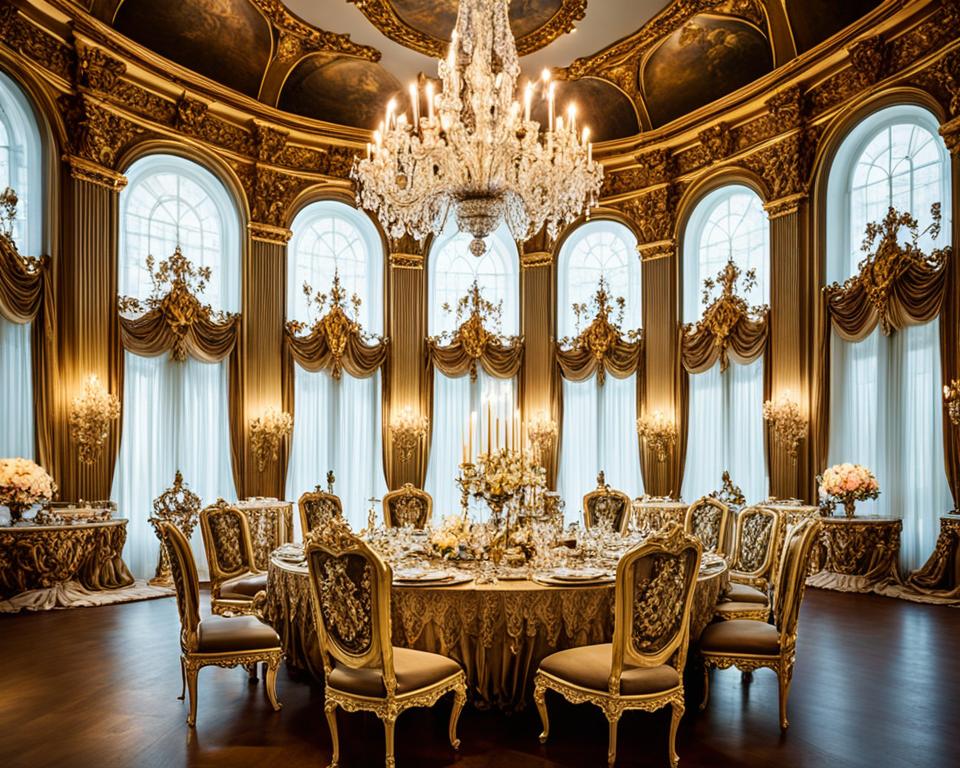
Baroque tables have a distinctive presence that captures attention and adds a touch of grandeur to your home. The elaborate carvings, exquisite details, and curvilinear forms are a testament to the unmatched artistry of the Baroque era. Whether placed in a formal dining room, a cozy living space, or a luxurious foyer, Baroque tables stand as captivating centerpieces that demand admiration.
These antique pieces embody the historical significance of the Baroque period while effortlessly blending with modern aesthetics. The juxtaposition of old-world charm and contemporary style creates a unique and eclectic ambiance that is both inviting and captivating.
When investing in vintage Baroque furniture, one can expect exceptional quality and durability. These carefully crafted pieces have withstood the test of time, preserving their beauty and functionality for centuries. Owning such exquisite antique furniture not only adds a touch of sophistication to your home but also connects you to a rich heritage of art and design.
In addition to their visual appeal, Baroque tables offer practicality and versatility. Their spacious tabletops provide ample space for dining, entertaining, or displaying cherished decor. The intricate carvings and elegant legs ensure stability and durability while exuding a sense of elegance and refinement.
Whether you are an avid collector or a homeowner looking to infuse your space with a touch of historical charm, Baroque tables offer a captivating solution. These historical relics, with their timeless elegance and undeniable presence, are sure to become cherished heirlooms that stand the test of time.
Conclusion
Baroque antique furniture, with its opulent designs and intricate craftsmanship, continues to captivate interior design enthusiasts. The beauty and allure of Baroque tables, whether German, Swiss, Italian, or Belgian in style, add a touch of timeless elegance to any space. These works of art from the Baroque era are not just furniture; they are pieces that tell stories of tradition, grandeur, and refined taste.
Incorporating Baroque antique furniture into your home brings a touch of history and sophistication that is sure to leave a lasting impression. The ornate carvings, luxurious materials, and exquisite detailing of classic Baroque furniture create a sense of opulence and splendor. Whether you choose a vintage Baroque table to make a bold statement or a piece of Baroque-style furniture to add a touch of elegance, you can be confident that it will elevate the aesthetic of any room.
Baroque antique furniture is a testament to the masterful craftsmanship and artistic expression of the Baroque period. Its intricate designs, ornate carvings, and curvilinear forms embody the opulence and sophistication of that era. Whether you prefer the grandeur of German Baroque furniture, the practical refinement of Swiss Baroque furniture, the sculptural elements of Italian Baroque tables, or the nature-inspired motifs of Belgian Baroque style, there is a piece of Baroque antique furniture that will speak to your individual taste and enhance the beauty of your home.
FAQ
What is Baroque antique furniture?
Baroque antique furniture refers to furniture pieces that were crafted during the Baroque period, which spanned from the late 16th to early 18th century. These furniture items are known for their ornate carvings, intricate detailing, and curvilinear forms, reflecting the opulence and grandeur of the Baroque era.
What are the characteristics of Baroque antique furniture?
Baroque antique furniture is characterized by its ornate carvings, intricate detailing, and curvilinear forms. It often features elaborate motifs like nature, cherubs, and mythological figures, creating a visually captivating narrative. The use of rich, dark woods like walnut and mahogany further emphasizes the luxurious and opulent appeal of Baroque furniture.
How did the Baroque style evolve over time?
The Baroque style evolved and gave birth to various sub-styles that retained the opulence of the original while incorporating unique regional and artistic influences. German Baroque furniture featured intricate carvings inspired by natural motifs and religious symbolism. Swiss Baroque furniture focused on refined and practical elegance. Italian Baroque furniture incorporated sculptural elements into its design, creating almost works of art. Belgian Baroque furniture often featured decorative carved motifs inspired by nature.
What are the characteristics of German Baroque furniture?
German Baroque furniture is characterized by intricately carved designs that draw from natural motifs and religious symbolism. These furniture pieces are often crafted from dark woods such as walnut and oak, with remarkable spiraling legs, elaborate carvings, and unique personalities that add character to any room.
How does Swiss Baroque furniture differ from other Baroque styles?
Swiss Baroque furniture leans toward a more refined and practical elegance compared to other Baroque styles. Made of massive walnut wood, Swiss Baroque tables often have a central slate slab for holding hot pots and can seat up to ten people. The dark wood lathed legs connected by a crossed stretcher give them stability and a touch of sophistication.
What sets Italian Baroque tables apart from other Baroque furniture?
Italian Baroque tables are known for their intricate carvings, voluptuous curves, and opulent materials. They often feature stunning cherry wood designs with intricate legs carved in a lyre-shaped walnut. These pieces showcase the masterful incorporation of sculptural elements into furniture, creating works of art that transcend their utilitarian purpose.
What are the characteristics of Belgian Baroque tables?
Belgian Baroque tables often have decorative carved motifs inspired by nature, such as foliage and flowers. They have bold, robust forms with curvaceous lines that give them a sense of movement and vitality. These tables, made of hand-carved oak with rocaille, flower, and leaf decorations, add charm and elegance to any living room or entryway.
Why is Baroque antique furniture still popular today?
In today’s era of minimalist and modern design, Baroque antique furniture has experienced a resurgence in popularity. Its intricate craftsmanship and artistic flair, combined with the timeless appeal of its ornate detailing, make it a sought-after addition to a variety of spaces. Baroque tables, in particular, inject elegance and opulence into any room, enhancing its classic charm and effortlessly integrating into rooms of any style.
What is the significance of incorporating Baroque antique furniture into a home?
Incorporating Baroque antique furniture into a home brings a touch of history and sophistication. These works of art from the Baroque era are not just furniture; they are pieces that tell stories of tradition, grandeur, and refined taste. Baroque tables, with their opulent designs and intricate craftsmanship, add a timeless elegance to any space, leaving a lasting impression on visitors.

